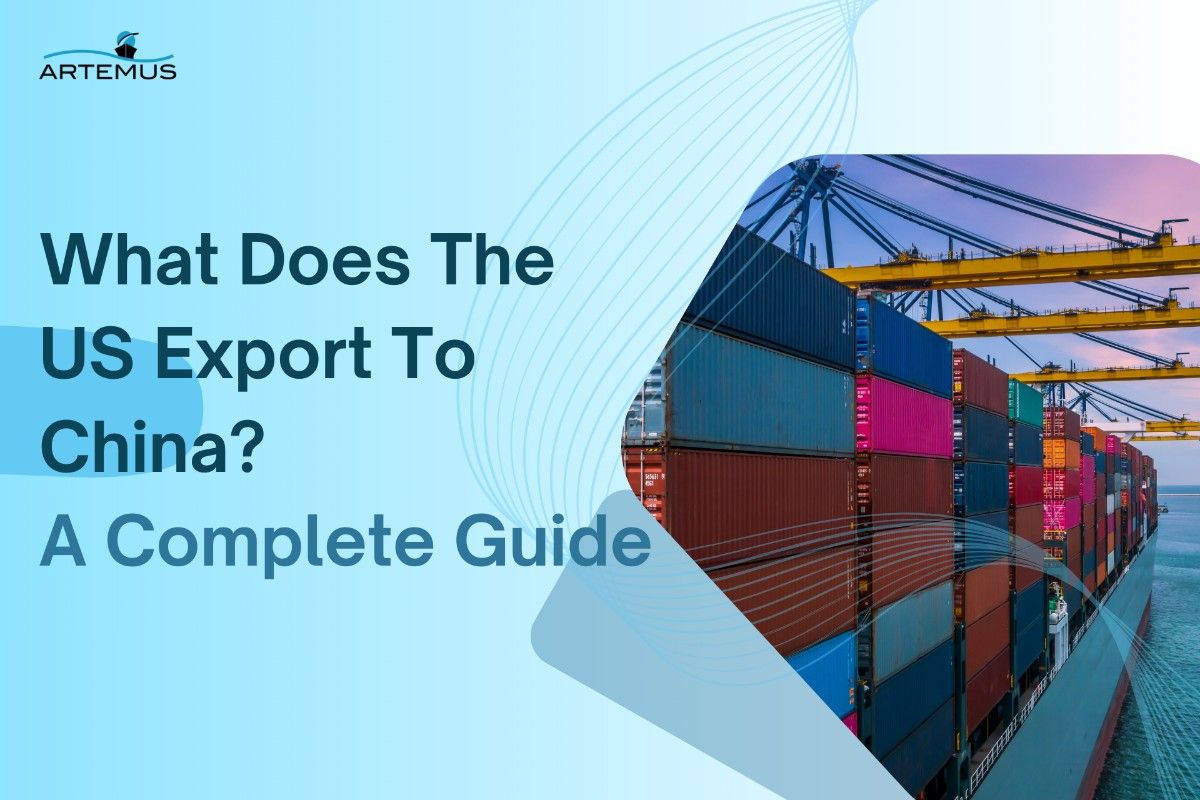
Japan Imports And Exports 2024: Top Products & Their Impact
Japan’s trade system is central to its economy, with imports like raw materials and food supporting its industries and population.

Navigating the timeframe of sea cargo transportation is essential for businesses engaged in international trade, influencing supply chain planning and customer expectations.
Amidst varying factors affecting transit times, including distance, vessel speed, and port operations, ensuring efficient sea cargo clearance is paramount.
Artemus offers vital support with Importer Security Filing (ISF) and Automated Manifest System (AMS) requirements, streamlining the clearance process and expediting sea cargo delivery.
Table Of Contents
Transit time for sea cargo refers to the duration it takes for shipments to travel between the port of origin and the port of destination. This timeframe encompasses the entire journey, including loading and unloading at ports, transit through waterways, and any potential stops or delays along the route.
Several factors influence transit time, such as the distance between ports, the shipping route taken, vessel speed, weather conditions, and any logistical or operational considerations.
Understanding transit times is essential for effective supply chain management, allowing businesses to plan inventory levels, coordinate production schedules, and meet customer delivery expectations.
Related: How To Import A Car To The United States? 2024 Regulations
Sea cargo transportation is a vital component of global trade, facilitating the movement of goods across vast distances. One of the most common questions in international logistics is, “How long does sea cargo take?”
The answer to this question varies based on several factors, each of which plays a significant role in determining transit times.
The primary factor affecting sea cargo transit time is the distance between the port of origin and the port of destination. Longer distances typically result in lengthier transit times. Factors such as ocean currents and navigational obstacles may also affect the time required for travel.
The chosen shipping route can significantly impact transit time. Direct routes may be faster, while routes with multiple stops or detours can prolong the journey. Route selection may be influenced by factors such as fuel costs, congestion at certain ports, and geopolitical considerations.
The speed of the cargo vessel plays a crucial role in determining transit time. Faster vessels can cover distances more quickly, reducing overall transit times. Vessel speed is influenced by factors such as fuel efficiency, weather conditions, and the need to comply with regulations aimed at reducing environmental impact.
Adverse weather conditions, such as storms or heavy seas, can delay sea cargo shipments. Inclement weather may force vessels to slow down or seek alternative routes for safety. Weather forecasts and monitoring systems are used to mitigate risks and plan routes accordingly.
Port congestion can occur due to high volumes of cargo or operational inefficiencies, leading to delays in vessel docking, loading, or unloading. Efforts to address port congestion include infrastructure upgrades, improved logistics planning, and the use of technology to optimize port operations.
The time taken for customs clearance at the destination port can impact overall transit time. Delays in customs processing can prolong the time it takes for cargo to be released for onward transportation. Electronic customs clearance systems and pre-arrival documentation submission help expedite the process.
If sea cargo requires transshipment at intermediate ports, additional time will be needed for the transfer of cargo between vessels, potentially extending the transit time. Transshipment hubs play a critical role in facilitating the transfer of cargo between different routes and shipping lines.
The type of container used for sea cargo, such as standard containers or specialized containers like refrigerated or hazardous cargo containers, can influence transit time due to handling requirements. Containerized cargo offers advantages such as easier handling and reduced risk of damage during transit.
The schedule maintained by the shipping carrier, including frequency of sailings and adherence to published schedules, can affect transit time predictability. Real-time tracking and monitoring systems provide visibility into vessel movements, enabling better planning and coordination.
Ensuring all necessary documentation is in order and complying with regulatory requirements can prevent delays in transit due to administrative issues or customs clearance challenges. Proper documentation includes bills of lading, certificates of origin, and any permits or licenses required for specific types of cargo.
Efficient document management systems streamline the process and reduce the risk of errors or omissions.
Related: How To Import From China To USA In 2024: Process & Costs
Transit times from different countries to the USA vary depending on several factors, including the origin country, shipping method, and specific port of entry. However, here is a general overview of transit times for sea cargo shipments from various regions to the USA:
Sea cargo shipments from countries in the Asia-Pacific region, such as China, Japan, South Korea, and Southeast Asian nations, typically have transit times ranging from 10 to 30 days, depending on the specific ports of origin and destination in the USA. Major ports in this region include Shanghai, Hong Kong, Singapore, and Busan.
Sea cargo shipments from European countries to the USA usually take around 10 to 20 days, depending on the distance and shipping route. Major European ports serving transatlantic trade include Rotterdam, Hamburg, Antwerp, and Southampton.
Transit times for sea cargo shipments from Latin American countries to the USA can vary widely, ranging from 5 to 30 days or more, depending on the distance and shipping route. Ports in countries such as Brazil, Mexico, Colombia, and Chile serve as major hubs for trade with the USA.
Sea cargo shipments from the Middle East and Africa to the USA generally have longer transit times, typically ranging from 20 to 40 days or more, depending on the specific countries and ports involved. Major ports in this region include Dubai, Jebel Ali, Durban, and Cape Town.
It’s important to note that these transit times are approximate and can be influenced by factors such as weather conditions, port congestion, vessel schedules, and customs clearance procedures.
Additionally, transit times may vary for different shipping methods, such as full container load (FCL) or less than container load (LCL), as well as for different modes of transportation, such as ocean freight, air freight, or land transportation.
Related: Top 10 Items Exported From India To USA: A 2024 List
Understanding the various types of sea cargo transit times is essential for efficient supply chain management. Here’s an overview:
Related: Poland’s Exports To USA: The Complete List For Opportunities
Managing sea cargo transit time effectively is essential for smooth logistics operations and timely delivery of goods. Here are some tips to help businesses optimize their sea cargo transit times:
Thoroughly plan and schedule shipments in advance, considering factors such as shipping routes, vessel schedules, and estimated transit times to ensure timely delivery and minimize delays.
Maintain open communication channels with shipping carriers, freight forwarders, and other logistics partners to stay informed about shipment status, potential delays, and any changes in transit schedules.
Implement tracking and monitoring systems to keep real-time tabs on the location and status of sea cargo shipments. This visibility allows for proactive management of transit times and enables timely intervention in case of any issues or delays.
Develop contingency plans to address unforeseen delays or disruptions in sea cargo transit, such as adverse weather conditions, port congestion, or customs clearance issues. Having backup strategies in place helps mitigate the impact of delays and ensures continuity of supply chain operations.
Related: Exporting Mangoes From India To The USA: How To Ship?

Artemus offers streamlined sea cargo clearance support, including assistance with Importer Security Filing (ISF) and Automated Manifest System (AMS) requirements. With Artemus, businesses can ensure compliance with U.S. Customs and Border Protection regulations, expedite the clearance process, and facilitate smooth import operations.
From accurate ISF filing to seamless communication with customs authorities, Artemus simplifies the complexities of sea cargo clearance.
Related: 10 International Shipping Documents To Must Have In 2024
Sea freight typically travels at speeds ranging from 15 to 25 knots (approximately 17 to 29 miles per hour).
Sea shipping takes longer due to factors such as slower vessel speeds, distance traveled, port operations, and potential delays caused by weather or customs procedures.
Sea shipping is often cheaper for transporting large volumes of goods over long distances compared to other modes of transportation like air freight.

In summary, sea cargo transportation duration varies due to factors like distance, route, vessel speed, weather, and port operations. Despite potentially longer transit times, sea shipping’s cost-effectiveness for large volumes over long distances makes it popular in international trade.
Understanding these factors helps businesses manage logistics effectively for timely delivery and efficient supply chain operations.
Related: How To Choose A Freight Forwarder? 10 Critical Aspects

Japan’s trade system is central to its economy, with imports like raw materials and food supporting its industries and population.

Exporting cars from the USA involves complying with legal and customs regulations. It requires proper documentation, including title and registration,

The United States exports a wide range of products to China, making it one of the largest trading relationships globally.
Get In Touch
Artemus’ Software Solutions for ISF, AMS, Japan AFR, eManifest Canada, & Panama B2B filings.